CAITHNESS FIELD CLUB BULLETIN
vol. 3 No. 5 April 1983
THE MULTIPLE STONE ROWS OF CAITHNESS AND SUTHERLAND
3. Their Description II
R. Freer and L.J. Myatt
This article is a continuation of the description of the settings of multiple
stone rows which was commenced in a previous edition of the Bulletin (Freer and
Myatt, 1982, 58).
11. Upper Dounreay I ND012660
The stone rows are situated in a hollow 60Om to the north-west of the two
long cairns of Cnoc Freiceadain and Na Tri Shean (Henshall 1963, 267, 282). They
are in an area which is quite rich in antiquities of the neolithic period. There
is the short horned cairn of Upper Dounreay to the west of the rows (Henshall
1963, 298) and beyond it a standing stone 2m high. To the south-east is a cairn
having set around it eight small stones which may be part of an elliptical
setting. There is also possible evidence of a neolithic quarry (Myatt 1977, 46).
 Figure 8 shows the plan of the survey carried out by the authors in 1975 with
the assumed geometrical pattern superimposed. The site, which is comparable in
extent with the more frequently visited setting at Mid Clyth was surveyed by Sir
Henry Dryden in 1871. Dryden's survey shows that there were more than twice the
number of stones to be found today, and the estimated positions of the
additional stones in Dryden's survey have been added to the plan. In fact, there
are so few stones visible today that without the addition of Dryden's stones it
would be difficult to establish any geometrical pattern. Around some of the
stones pits have been dug possibly as a preliminary to removing them.
Figure 8 shows the plan of the survey carried out by the authors in 1975 with
the assumed geometrical pattern superimposed. The site, which is comparable in
extent with the more frequently visited setting at Mid Clyth was surveyed by Sir
Henry Dryden in 1871. Dryden's survey shows that there were more than twice the
number of stones to be found today, and the estimated positions of the
additional stones in Dryden's survey have been added to the plan. In fact, there
are so few stones visible today that without the addition of Dryden's stones it
would be difficult to establish any geometrical pattern. Around some of the
stones pits have been dug possibly as a preliminary to removing them.
The suggested geometrical construction on the plan shows radial lines similar
to those at Garrywhin, again with rows of stones parallel to them. In the centre
of the site the sets of lines overlap and some have been omitted from the
diagram for clarity.
The inclinations of the radial lines to the assumed axis OE are given in
Table 4.
| Radial Line |
OA |
OB |
OC |
OD |
OF |
OG |
OH |
| Inclination to axis OE |
19o36' |
14o44' |
9o48' |
4o52' |
9o48' |
19o36' |
24o19' |
TABLE 4
On the higher ground to the west of the rows, but within the geometrical
construction, are two low grass-covered mounds.
Any astronomical observation from this site could possibly have been of the
moon rising in its extreme northerly position which would be just visible over
the island of Hoy, Orkney.
12. Upper Dounreay II ND007660
Nothing is known of this setting of stone rows. It is shown as a 'site of'
stone rows on the 1:10000 O.S. map, 500m to the west of Upper Dounreay I. Since
the map also shows field drains in this area, there is a possibility that the
stone rows may have been removed at the time the drains were laid.
13. Skelpick NC722574
This setting of stones, first recorded by Myatt (1975,55), was destroyed in
1982. The results of a hurried survey carried out in 1975 are shown in figure 9.
A total of eleven small stones were to be seen protruding above the surface, the
tallest not more than 20cm high. Exploring the surface with a probe revealed the
positions of other possible stones shown on the plan.
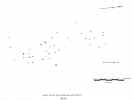 The ground in which the setting occurs rises very slightly to the north, with
higher ground at both the northern and southern extremities. On the higher
ground at the north is an enclosure; 200m to the north-east on steeply rising
ground are the remains of a broch, and there are a number of chambered cairns in
the vicinity.
The ground in which the setting occurs rises very slightly to the north, with
higher ground at both the northern and southern extremities. On the higher
ground at the north is an enclosure; 200m to the north-east on steeply rising
ground are the remains of a broch, and there are a number of chambered cairns in
the vicinity.
No attempt has been made to superimpose a geometrical construction on the
plan because of the uncertainty of the positions of the buried stones, although
the pattern does suggest that there may be parallel rows.
That this site had been destroyed merely emphasises the vulnerability of this
type of monument. The number of such sites to be found today may be only a
fraction of those originally set out.
14. Borgie NG661587
Stone rows were first recorded (Ordnance Survey 1978, 46) at this location as
a result of survey work carried out by the Archaeology Branch of the Ordnance
Survey.
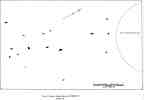 Figure 10 shows the results of a survey carried out by Myatt in 1981
Figure 10 shows the results of a survey carried out by Myatt in 1981
The setting is on sloping ground near to the Bettyhill-Tongue road (A836).
Unfortunately there has been extensive peat cutting in the area and a total of
only sixteen stones now remain to the north of a small stream Allt Loch
Tuirslighe. The ground slopes upwards to the north east at which end is a low
peat-covered mound with no visible features. The stones are rounded boulders of
local stone, the tallest being about 20cm above the surface, and all are firmly
set in the ground.
Because of the small number of stones and their distribution no geometrical
construction is suggested on the plan. If they were originally set out in rows
their alignment was possibly approximately north-east and south-west.
15. Loch Rimsdale NC716348
Members of Glasgow University Archaeological Society first recorded this site
(Gourlay 1975, 7) to the west of Loch Rimsdale whilst undertaking field work in
the latter part of 1975. A survey wag carried out because the area was in
imminent danger of archaeological destruction by deep ploughing for the Forestry
Commission.
The rows lie almost hidden on the saddle of Cnoc Bad na Fainne and
in the immediate vicinity is a standing stone with its flat axis directed
towards Morven prominent on the horizon almost 30km away.
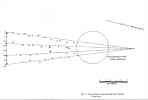 The plan of Figure 11 is based upon details given in the above report. The
superimposed geometrical construction shows the 41 stones lying along four
radiating fan-shaped rows. At the southern end of the setting the four stones
terminating the rows are larger than the rest. They are shown set on an arc of
radius 27.5my (11mr) about the centre 0. This arc is divided by the
intersections with the rows in distances of 2.5, 2.5 and 2.0my respectively from
west to east.
The plan of Figure 11 is based upon details given in the above report. The
superimposed geometrical construction shows the 41 stones lying along four
radiating fan-shaped rows. At the southern end of the setting the four stones
terminating the rows are larger than the rest. They are shown set on an arc of
radius 27.5my (11mr) about the centre 0. This arc is divided by the
intersections with the rows in distances of 2.5, 2.5 and 2.0my respectively from
west to east.
Situated symmetrically about the main axis of the setting and towards the
centre of the sector is a small mound of about 6m diameter. Although it has the
appearance of a field clearance cairn, its purpose could be otherwise.
16. Badanloch NC782351
On ground rising gradually towards the top of Cnoc Molach, and 0.5km from the
shore of Loch Badanloch, is a setting of 18 small stones in a fan- shaped array.
The largest stones, of which the tallest is 62cm, stand at the base of the fan
and the ground slopes upwards towards its centre.
This site which is about 6.5km east of that at Loch Rimsdale was first
recorded (Ordnance Survey 1977, 49) by the Archaeology division of the Ordnance
Survey.
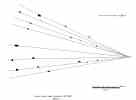 Figure 12 shows the results of a survey by Myatt in 1982. A conjectural
geometrical construction shows the stones set along eight radiating rows.
Further investigation on this site might reveal additional stones concealed
beneath the surface of the peat-covered ground.
Figure 12 shows the results of a survey by Myatt in 1982. A conjectural
geometrical construction shows the stones set along eight radiating rows.
Further investigation on this site might reveal additional stones concealed
beneath the surface of the peat-covered ground.
In the vicinity at NC781356 is evidence of a burnt mound, and also a probable
cairn at NC782353.
17. Kinbrace NC827322
This group of stones, first reported by Myatt (1975, 54), is near to the
ruined chapel site and burial ground at Ach' na h-Uai' north of the B871 road.
They are set in rough ground on a slight slope overlooking the river Helmsdale
to the south.
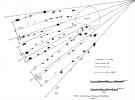 The result of the survey carried out by Freer is shown in Figure 13. A
possible geometrical pattern has been superimposed on the survey, but because
the stones cover only a small area the pattern is difficult to establish with
certainty. They are shown lying in groups of rows parallel to the radial lines
OA,,OB, OC and OD, with a spacing of 4my between the outer rows of the groups.
It is interesting to draw a comparison with the geometry of the Caithness sites
at Upper Dounreay and Garrywhin where a similar geometry shows a spacing of 4mr.
The result of the survey carried out by Freer is shown in Figure 13. A
possible geometrical pattern has been superimposed on the survey, but because
the stones cover only a small area the pattern is difficult to establish with
certainty. They are shown lying in groups of rows parallel to the radial lines
OA,,OB, OC and OD, with a spacing of 4my between the outer rows of the groups.
It is interesting to draw a comparison with the geometry of the Caithness sites
at Upper Dounreay and Garrywhin where a similar geometry shows a spacing of 4mr.
The inclinations of the radial lines to the assumed axis OC are given in
table 5.
TABLE 5
| Radial Line |
OA |
OB |
OD |
| Inclination to axis OC |
19o36' |
9o48' |
9o48' |
All the stones are small rounded boulders of local stone with noticeably
taller stones at the south-east ends of the rows. The ground rises slightly to
the centre of the fan at 0, and immediately adjacent to the rows at the
north-west end is a small low mound. It is peat covered and roughly circular in
plan.
In the vicinity of this site are the remains of chambered cairns, hut circles
and old field boundaries. Running close to the outer circumference of the fan is
the track of an old road. The modern road runs 300m to the south of this.
Investigating the possibility of astronomical alignments at this site, it was
observed that the radial line OE indicates the direction of a notch formed
between the slopes of An Cnoc Buidhe and Eldrable Hill at the southern end of
Strath Kildonan. When the moon rises at its extreme southerly position it would
be seen to be just touching this notch by an observer looking along the line OE.
18. Learable Hill NC892234
In the Strath of Kildonan, to the west of the River Helmsdale near Suisgill
Lodge, and below the summit of Learable Hill are numerous rows of small stones
crossing over the hill. Set with their broad faces in the line of the direction
of the rows, they are of local stone varying in height above the surface from
30cm to 60cm. Near to the rows is a single standing stone 1.6m high inscribed
with a plain Christian cross. Numerous small peat-covered mounds, some of which
are across the rows, scatter the area.
To the west of the site the ground rises gradually, but to the east it falls
fairly steeply and, in the distance, the horizon exhibits the quite distinct
peaks of the far hills on the skyline.
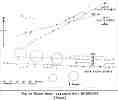 A plan of part of this site, surveyed by Thom (1967, 153), is reproduced in
Figure 14. It shows four possible parallel rows of stones separated by a
distance of 2my and, further to the north, two rows which intersect. The full
extent of the intersecting rows is not shown on this plan since they extend
further eastwards down the slope of the hill.
A plan of part of this site, surveyed by Thom (1967, 153), is reproduced in
Figure 14. It shows four possible parallel rows of stones separated by a
distance of 2my and, further to the north, two rows which intersect. The full
extent of the intersecting rows is not shown on this plan since they extend
further eastwards down the slope of the hill.
Evidence has been shown (Thom 1967, 110) for the possible use by the megalith
builders of a sixteen month calendar with either 22 or 23 days in each month.
Indication of significant calendar days are found from the alignments of stones.
These give the position of sunrise or sunset along the horizon at the beginning
of each month, and similar directions have been found at a number of different
sites. In the calendar suggested by Thom, the directions of the rows shown in
Figure 14 is significant in that the alignments are such that they would
indicate the position of the rising sun on three of three calendar dates.
The row having an azimuth of 62o.0 would indicate the position of the rising
sun at the beginning of May at about the time of the Celtic festival of Beltaine.
Using our present calendar the sun would rise along the direction of this row on
6 May.
Towards the end of August, on the 29th using our present calendar, the sun
would rise along the row having an azimuth of 75o.0; and the alignment of the
parallel rows is such that they would indicate the position of the rising sun at
the equinoxes.
19. Kildonan NC955185
The inventory of ancient monuments in Sutherland (RCAHMS 1911,133) describes
stone rows at Allt Breac on the south side of the road leading up the Strath of
Kildonan. A plan shows about 14 fan-shaped rows close to the side of the road.
On the opposite side of the road are two large cairns.
A recent search (1982) in this area did not reveal the existence of this
site. There is now a layby at this point on the south side of the road and
possibly the stones have either been buried or removed.
20. Kildonan NC966189
A further site described in the Sutherland inventory (RCAHMS 1911, 132) is
the setting of stone rows at Torrish Burn. The two rows of stones as shown in
the survey of Figure 15 consist of fairly large boulders set in the ground
rising steeply to the west near the top of a natural hillock. Surmounting the
hillock is a low rectangular-shaped mound approximately 8m x 4m which has a
number of small stones protruding around its periphery.
The tallest of the stones is 52cm high and the two rows converge slightly as
they run down the slope to the east.
From their appearance it is not certain that these rows form part of the same
class of monument as the other sites described.
A New Caithness Site
Since the preparation of this article, a new site has been recorded, by the
Archaeology Division of the Ordnance Survey, in Caithness at Tormsdale. Once an
accurate large scale survey of this site, which is quite extensive, has been
carried out, it will be described in a future edition of the Bulletin.
Acknowledgement
1 . The authors gratefully acknowledge permission given by Oxford University
Press to reproduce Figure 14.
R E F E R E N C E S
Freer, R. & The Multiple Stone Rows of Caithness G.F.C. Bull. 1982
Myatt, L.J. and Sutherland 2 Vol.3 No.3
Gourlay, R. A Field Survey in the Loch Rimsdale Area Glasgow 1975
Henshall, A.S. The Chambered Tombs of Scotland Vol.1 Edinburgh 1963
Myatt, L.J. Discovery & Excavation in Scotland SRGA 1975
Myatt, L.J. Two Possible Prehistoric Quarries in C.F.C. Bull. 1977
Caithness Vol.2 No.1
Ordnance Survey Discovery & Excavation in Scotland SRGA 1977
Ordnance Survey Discovery & Excavation in Scotland SRGA 1978
RCAHMS Second Report and Inventory of Edinburgh 1911
Monuments and Constructions in the HMSO
County of Sutherland

















